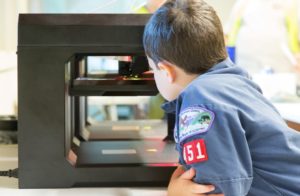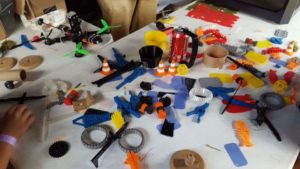 A few weeks ago, the entire United States got excited about the solar eclipse that would appear across the country, with the sun becoming fully blocked by the moon in several states. Events were held around the country to observe and celebrate the eclipse, and one of those events was led by Jeffry Turnmire, an engineer and Boy Scout leader who used the natural phenomenon as a way to teach hundreds of people in the Smoky Mountains about technology including 3D printing.
A few weeks ago, the entire United States got excited about the solar eclipse that would appear across the country, with the sun becoming fully blocked by the moon in several states. Events were held around the country to observe and celebrate the eclipse, and one of those events was led by Jeffry Turnmire, an engineer and Boy Scout leader who used the natural phenomenon as a way to teach hundreds of people in the Smoky Mountains about technology including 3D printing.
Turnmire may not be a traditional classroom teacher, but his passion about 3D printing has led him to teach children and adults alike about the technology through different programs he has put together. He is now an official MakerBot Educator, and through his work has reached as many individuals as regular teachers do. He was also a speaker for our recent Advanced Design for 3D Printing online course, and will be presenting a session on Analysis with Fusion 360 in our upcoming course, 3D Printing for Prototyping and Production, next month. Turnmire recently took the time to speak with us about his work and how he is helping people to learn about 3D printing for our Spotlight on Educators series.
Tell us about yourself, your background and current work.
“I am a civil engineer by schooling and trade. I am a maker and tinkerer at heart. I have a degree in civil engineering from the University of Tennessee. I have been working in the family engineering business for more than 25 years (since way before my college degree). I have been designing in 3D for at least 20 of those years. Current work involves concept, design, and construction of a mix of residential, commercial, and industrial sites. We design projects including residential subdivsions, marinas, restraunts, and even landfills. I have also been in Boy Scouts of America for over 30 years, started as a young man in 2nd grade and progressed up through the rank of Eagle Scout, and now pay it forward as an adult volunteer.”
How and when did you first learn about/become interested in 3D printing?
“Before the maker movement really got established people like me were called tinkerers – dabbling in lots of things and making/creating things. I was invited to be one of the first subscribers to Makezine and just through that whole scene I pretty much followed 3D printing as people developed it on the home accessible scale. I went many painful years before the prices of 3D printers finally came down to my reach. After I got the first one for Christmas in 2015, I quickly became the owner of 2 more in 2016.”
When did you begin teaching others about 3D printing?
“Once I had the first printer, I started creating pinewood derby trophies for my cubscouts and the upcoming pinewood derby race in March 2016. The evolution of ideas led to me also creating a 3D printed wood filament derby car to run in the 2016 race. Just by showing up with a 3D printed car led me to start teaching lots of people about 3D printing. Also, early in 2016 my local Boy Scouts of America Council was planning a large event they were calling ScoutFest 2016 that was to take place in October. They were expecting 1500 participants and wanting me to run the 3D Printing demonstration. I started looking for companies that might be interested in coming to do a demo with me. That rabbit hole led to contacting Makerbot, then becoming a Makerbot Educator and designing educational projects published on Thingiverse. The projects I have created and published have helped other educators teach an uncountable and growing number of students with and about 3D printing around the globe.”
How have you used 3D printing as a teaching tool?
“So far I have mainly published projects and done large scale demonstrations teaching with 3D printing. The most recent demo I did was for the great American eclipse of 2017. We had 750 people come to the local Great Smoky Mountain Council scout camp to experience totality. I prepared over 200 3D printed pinhole viewers, then showed people how to watch the eclipse progress with those instead of looking up with your glasses on. I also had 3D printers and a cnc laser etcher going to show to the participants. Then just this past Friday, I was at a local radio station doing a demonstration for the morning radio talent explaining how 3D printing works while they asked questions and did a live video stream on the web where over 1000 people were watching.”
How have people responded to the 3D printing programs you have facilitated?
“3D printing definitely captures the imagination of nearly everyone that has come through any of my demos. Endless questions from inquisitive minds. The response has been great. Many people have asked if I would teach a class for their group or come talk to a different group.”
What kinds of 3D printers do you use as a maker and an educator?
“I have a HobbyKing Fabrikator, a generic prusa i3 style printer that I have heavily modified, a grbl based generic DIY cnc mill/laser, and a Makerbot 5th Generation. The prusa is my favorite for versatility, however it is not designed for easy travelling. The mill is a mill not a printer, but it travels well and the laser attachement is facinating to many. The Makerbot is the easiest to pickup and go to a demonstration with, although it is fairly bulky. I feel the polish of the Makerbot system lends itself best to the big events I have done. Just a power cord and you are good to go, no extra wires hanging around, no computer, just the machine. The Makerbot lets the participants focus on the printing instead of the printer and all its sensors, motors, and parts.”
 What are some of the reasons why you feel it’s important for young people to learn about 3D printing?
What are some of the reasons why you feel it’s important for young people to learn about 3D printing?
“I can see the day where you go to the local store and print out a part for something you need fixed, or even get a customized for you widget made for you right while you wait. If young people are taught about and become interested in these technologies they are better prepared for the future that they will live in. Mass manufacturing by humans in a plant has been on the decline for a long while, and 3D printing is just another evolutionary stepping stone in my opinion. Young people have a chance to be early experts in the field of 3D printing and grow up with 3D printing as it progresses.”
What are some of the challenges and rewards you have experienced in introducing 3D printing to both kids and adults?
“Some of the challenges for me have been: How do you prepare for a 3D print demo event with 60, 200, 750, or 1500 people expected? (those are all sizes of events I have done) It takes work and planning. How many giveaways do you make ahead? 30% of the expected attendance seems to be a good starting point. What can you print during a demonstration that is interesting to see? I used makerbot demo prints for one, and then came up with some of my own pieces that are interesting. Having a part that prints in around 30-40 minutes has proven to be engaging with many of my participants. Some will stand there and watch the whole part print, completely mesmerized the entire time. Then simply the sheer number of questions and variety of questions and balancing that with giving as many people an opportunity to see and experience 3D printing as possible. Nothing really prepares you for that I think, just experience of doing it.
The rewards for me are just seeing that spark in the eye and look of amazement when they see the parts or watch the machine. Paying it forward (to both youth and adults).”
3D printing is becoming seen as a vital subject to be taught in schools; however, not all schools have the financial resources to implement 3D printing in the classroom. It’s also an important skill for adults to learn, as well, but most people in the workforce today didn’t have a chance to learn about it when they were in school. It’s therefore critical that there are people like Turnmire who dedicate their time and knowledge to educating people about 3D printing outside a formal classroom setting. Kids and adults can both learn about the technology through interactive programs like the ones he provides – and he does so in engaging, fun ways that draw people in and show them how exciting and useful 3D printing really is.
If you are interested in sharing your story, or know an educator we should get in touch with, please reach out any time. Send us an email or connect on Twitter. We’re looking forward to sharing your stories. Find all the features in this series here.
Share your thoughts on this interview and other 3D printing topics at 3DPrintBoard.com, or comment below.
[All images courtesy of Jeffry Turnmire]Subscribe to Our Email Newsletter
Stay up-to-date on all the latest news from the 3D printing industry and receive information and offers from third party vendors.
You May Also Like
3D Printing Financials: Fathom Struggles in Financial Quicksand During Critical Transition
Facing a year of key transitions and financial pressures, Fathom (Nasdaq: FTHM) has filed its annual report for 2023 with the U.S. Securities and Exchange Commission (SEC). The document outlines...
Latest Earnings Overview for Australian 3D Printing Firms Titomic and AML3D
Australian 3D printing manufacturing firms Titomic (ASX: TTT) and AML3D (ASX: AL3) reported their financial results for the period from July to December 2023, marking the first half of their...
3D Printing Webinar and Event Roundup: April 7, 2024
Webinars and events in the 3D printing industry are picking back up this week! Sea-Air-Space is coming to Maryland, and SAE International is sponsoring a 3D Systems webinar about 3D...
3D Printing Financials: Unpacking Farsoon and BLT’s 2023 Performance
In the Chinese 3D printing industry, two companies, Farsoon (SHA: 688433) and Bright Laser Technologies, or BLT (SHA: 688333), have recently unveiled their full-year earnings for 2023. Farsoon reported increases...



































